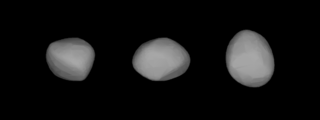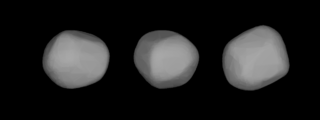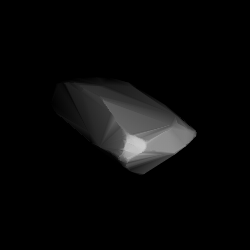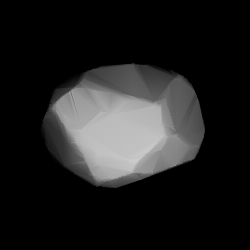
944 Hidalgo is a centaur and unusual object on an eccentric, cometary-like orbit between the asteroid belt and the outer Solar System, approximately 52 kilometers in diameter. Discovered by German astronomer Walter Baade in 1920, it is the first member of the dynamical class of centaurs ever to be discovered. The dark D-type object has a rotation period of 10.1 hours and likely an elongated shape. It was named after Mexican revolutionary Miguel Hidalgo y Costilla.

Lydia is a large belt asteroid with an M-type spectrum, and thus may be metallic in composition, consisting primarily of nickel-iron. It was discovered by French astronomer Alphonse Borrelly on 19 April 1870 and was named for Lydia, the Asia Minor country populated by Phrygians. The Lydia family of asteroids is named after it.

Liberatrix is a main-belt asteroid. It has a relatively reflective surface and an M-type spectrum. Liberatrix is a member of an asteroid family bearing its own name.

165 Loreley is a main-belt asteroid that was discovered by C. H. F. Peters on August 9, 1876, in Clinton, New York and named after the Lorelei, a figure in German folklore.

196 Philomela is a large and bright main-belt asteroid. It is an S-type asteroid.

Unitas is a typical main belt asteroid that was discovered by Elia Millosevich on 1 March 1891 in Rome. The asteroid was named by the director of the Modena Observatory in honor of the Italian astronomer Angelo Secchi and the unification of Italy. It is classified as an S-type asteroid.

391 Ingeborg is an asteroid and second-largest Mars-crosser on an eccentric orbit from the asteroid belt. It was discovered by German astronomer Max Wolf on 1 November 1894, at the Heidelberg Observatory in southwest Germany. When discovered, it was observed for a couple of weeks, and follow-up observations were made in 1901 and 1904. The stony S-type asteroid has a rotation period of 26.4 hours and measures approximately 17 kilometers in diameter. Any reference of the asteroid's name to a person is unknown.

Aspasia is a large main-belt asteroid that was discovered by French astronomer Auguste Charlois on 9 December 1895 in Nice. It is classified as a CX-type asteroid.

Diotima is one of the larger main-belt asteroids. It is classified as a C-type asteroid and is probably composed of primitive carbonaceous material.

776 Berbericia is a minor planet orbiting the Sun. A main-belt C-type asteroid, it was discovered on 24 January 1914 by astronomer Adam Massinger at Heidelberg Observatory in southwest Germany. It was named by Max Wolf in honor of Adolf Berberich (1861–1920), a German astronomer. The spectra of the asteroid displays evidence of aqueous alteration.

881 Athene is a stony background asteroid from the central region of the asteroid belt. It was discovered on 22 July 1917, by astronomer Max Wolf at the Heidelberg-Königstuhl State Observatory in southwest Germany. The likely elongated S/L-type asteroid has a rotation period of 13.9 hours and measures approximately 12 kilometers in diameter. It was named after Athena, the goddess of wisdom in Greek mythology.

1772 Gagarin is a stony background asteroid from the central region of the asteroid belt, approximately 9 kilometers in diameter. It was discovered on 6 February 1968, by Russian astronomer Lyudmila Chernykh at the Crimean Astrophysical Observatory in Nauchnyj, on the Crimean Peninsula. The asteroid was named after cosmonaut Yuri Gagarin.

1672 Gezelle, provisional designation 1935 BD, is a carbonaceous asteroid from the outer region of the asteroid belt, approximately 27 kilometers in diameter. It was discovered on 29 January 1935, by Belgian astronomer Eugène Delporte at Royal Observatory of Belgium in Uccle, Belgium. It was later named after Flemish poet and Roman Catholic priest Guido Gezelle.

1188 Gothlandia, provisional designation 1930 SB, is a stony Florian asteroid from the inner regions of the asteroid belt, approximately 12 kilometers in diameter. Discovered by astronomer Josep Comas i Solà at the Fabra Observatory in 1930, the asteroid was later named after the ancient name of the Spanish autonomous community of Catalonia.

1825 Klare is a background asteroid from the central region of the asteroid belt, approximately 15 kilometers in diameter. It was discovered on 31 August 1954, by German astronomer Karl Reinmuth at Heidelberg Observatory in southern Germany. The asteroid was named after Heidelberg astronomer Gerhard Klare.

1459 Magnya, provisional designation 1937 VA, is a basaltic, slightly elongated asteroid from the outer regions of the asteroid belt, approximately 20 kilometers in diameter. Discovered by Grigory Neujmin at the Simeiz Observatory in 1937, this background asteroid was later named from the Latin word "Magnya", which means "clear, bright, wonderful" when literally translated into Russian. It is the only known basalt asteroid orbiting beyond 4 Vesta.

1368 Numidia, provisional designation 1935 HD, is a stony background asteroid from the central regions of the asteroid belt, approximately 19 kilometers in diameter. It was discovered on 30 April 1935, by South African astronomer Cyril Jackson at the Union Observatory in Johannesburg. The asteroid was named after the ancient North African kingdom of Numidia.

1389 Onnie, provisional designation 1935 SS1, is a stony Koronian asteroid from the outer region of the asteroid belt, approximately 13 kilometers in diameter. It was discovered on 28 September 1935, by Dutch astronomer Hendrik van Gent at Leiden Southern Station, annex to the Johannesburg Observatory in South Africa.

1207 Ostenia, provisional designation 1931 VT, is a stony Eoan asteroid from the outer region of the asteroid belt, approximately 23 kilometers in diameter. It was discovered on 15 November 1931, by German astronomer Karl Reinmuth at Heidelberg Observatory in southwest Germany, and named for amateur astronomer Hans Osten.

1793 Zoya, provisional designation 1968 DW, is a stony Florian asteroid from the inner regions of the asteroid belt, approximately 9 kilometers in diameter. It was discovered on 28 February 1968, by Russian astronomer Tamara Smirnova at the Crimean Astrophysical Observatory in Nauchnyj, on the Crimean peninsula, and named after World War II partisan Zoya Kosmodemyanskaya.




















